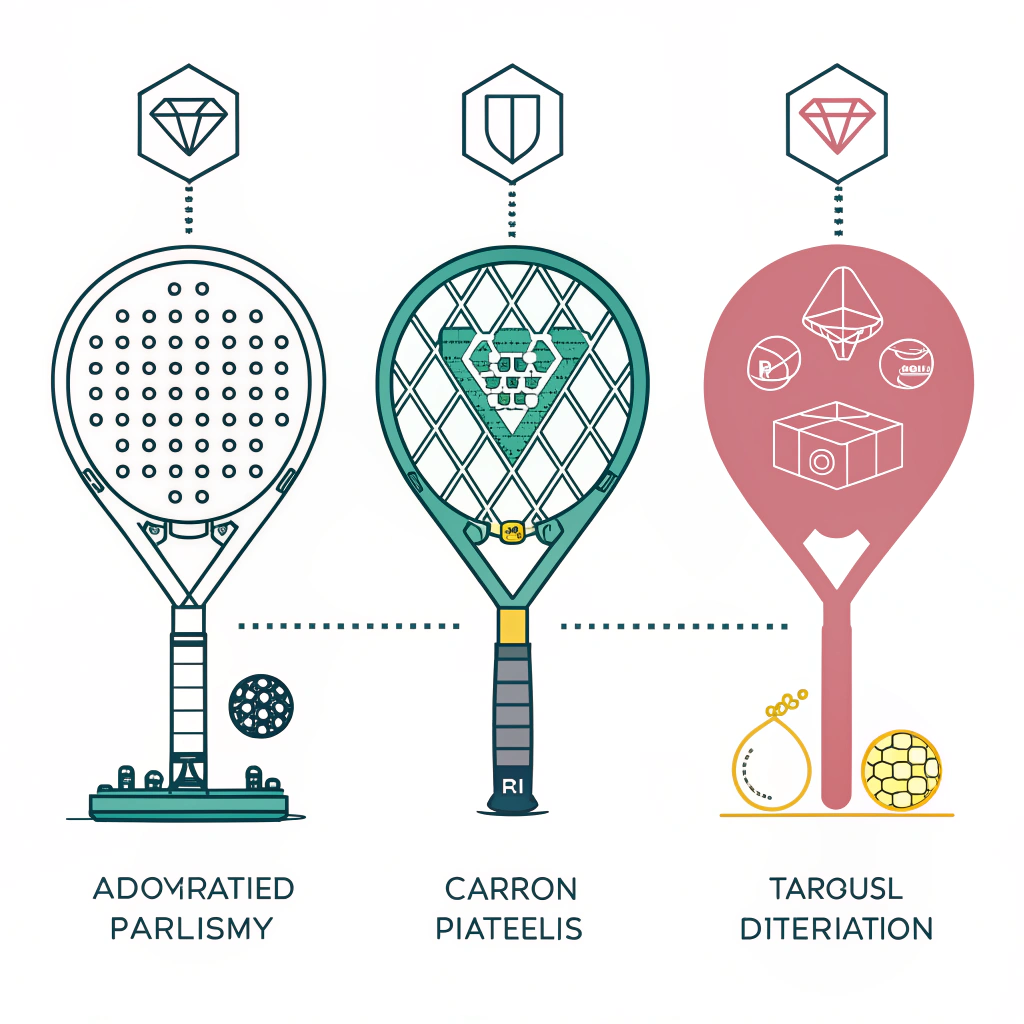Innovative padel racket design and advanced materials such as carbon fiber1 and fiberglass2 deliver a competitive edge for B2B buyers by enhancing performance, durability, and customization options. In today’s fast-paced sports equipment industry, investing in cutting-edge technologies is critical for market success.
Padel is no longer just a recreational sports game—it has morphed into a competitive market where performance optimization and product differentiation are key. Manufacturers and procurement managers must navigate design dilemmas and technological shifts to meet consumer demands and regulatory standards. Some of the common challenges include:
• Managing production timelines while ensuring quality
• Balancing cost and performance in material selection
• Meeting increasingly specific consumer and professional requirements
• Integrating customization options that enhance brand value
Companies like NEX Padel are tackling these issues by implementing advanced production techniques3 that utilize materials ranging from fiberglass to high-performance carbon fibers (such as 3k, 12k, and 18k variants). These innovations allow manufacturers to create high-performance rackets with dynamic design options (Diamond, Round, and Teardrop shapes) while also enabling full customization to cater to market demands.
The selection of materials and design shapes plays a pivotal role in the final performance of padel rackets. Let’s take a closer look at some core comparisons:
The choice between fiberglass and different grades of carbon fiber has significant implications for racket performance.
| Material Type | Performance Attributes | Ideal For | Key Considerations |
|---|---|---|---|
| Fiberglass | High elasticity, cost-effective | Entry-level rackets, hybrid builds | Lower stiffness compared to carbon fibers |
| 3k Carbon Fiber | Lightweight, easy to shape, balanced | Intermediate performance | Lower cost than higher-grade fibers |
| 12k Carbon Fiber | Increased stiffness, better energy transfer | High-performance rackets | Higher production precision required |
| 18k Carbon Fiber | Elite performance, maximum durability | Premium, professional-level products | More expensive and complex manufacturing |
Each material offers unique benefits. Fiberglass often serves as a cost-effective solution for developing initial prototypes or hybrid models. In contrast, the range of carbon fiber (3k, 12k, 18k) provides solutions for varied performance needs, where higher grade fibers result in stiffer and more powerful rackets. Integration of these materials is governed by advanced production techniques that ensure reliability and durability in every product.
Innovative designs extend beyond materials. Shape is a critical factor when tailoring racket performance to different play styles.
| Racket Shape | Impact on Gameplay | Advantages | Potential Drawbacks |
|---|---|---|---|
| Diamond | Emphasizes power shots; risk of reduced control | Enhanced strength at the racket’s head | May be harder to balance and control |
| Round | Promotes control and maneuverability | Superior balance and ease of swing | Less concentrated power delivery |
| Teardrop | A compromise between power and control | Balanced performance attributes | Requires precise tuning of weight distribution |
The Diamond shape is synonymous with maximum power; however, it may sacrifice some control, which affects play strategy. The Round shape, favored for its control and balanced feel, may not deliver the explosive power needed by some advanced players. Teardrop shapes focus on creating a synergy between power and control, making them an attractive option for players who desire versatility.
Manufacturers like NEX Padel leverage customizable designs—offering shape, color, prints, and even custom logos on hand grips and racket covers—so B2B clients can match market trends and consumer expectations perfectly.
Embracing innovation is not solely a function of material selection; the integration of advanced production techniques plays a central role in meeting market demand. Here are key factors that drive innovation in padel racket manufacturing:
-
Precision Engineering4:
Advanced machinery and automated processes enable manufacturers to work with delicate materials such as carbon fiber. The precision ensures consistency across batches, which is critical when a high-performance product is expected to meet rigorous professional standards. -
Rapid Prototyping and Fast Turnaround:
Being able to produce fast samples and iterate quickly is essential in a competitive industry. This capability allows companies to test market responses, refine designs, and launch products swiftly. -
Customization at Scale:
Today’s market demands personalized products. NEX Padel offers extensive customization options—from full shape customization, color variations, to logo printing on hand grips and racket covers. This customization not only adds a unique value proposition but also strengthens brand identity for their partners.
An additional advantage of modern production techniques is the maintenance of high reliability and quality control throughout the manufacturing process. Streamlined production practices ensure minimal defects while adhering to the tight deadlines typical for B2B orders. Companies involved in OEM projects5 (for brands like Hirostar, Reebok, and Starvie) depend upon these reliable techniques to maintain production schedules and market reputation.
Quality control protocols such as material testing, stress simulations, and performance analytics are built into each production stage. These practices ensure that each padel racket produced meets strict performance and durability benchmarks expected by professional athletes and everyday users alike.
For procurement managers and product development leads, selecting the right manufacturing partner involves a careful evaluation of multiple factors. Consider the following guidelines when comparing innovation offerings from padel racket manufacturers:
-
Material and Performance Alignment:
Evaluate whether the material choices (fiberglass, various grades of carbon fiber) align with your product’s target performance. -
Customization Capabilities:
Determine if the manufacturer offers full customization to tailor designs, including custom shapes, color schemes, and branding elements. -
Production Efficiency and Turnaround:
Look into the production lead times and the manufacturer’s ability to quickly produce samples and meet bulk order deadlines. This is crucial in a dynamic market where timing is everything. -
Technical Expertise and Industry Experience:
Ensure the manufacturer has a proven track record in advanced production techniques. Look for partnerships or case studies with recognized brands as a measure of reliability. -
Cost vs. Performance Balance:
Analyze the cost implications of the selected technology. Higher-grade materials and added customization naturally command higher prices. The key is to ensure that the investment translates to a product positioned at the premium end with a justifiable profit margin.
Below is a summary table that encapsulates the decision-making factors:
| Decision Factor | Key Considerations | Questions to Ask the Supplier |
|---|---|---|
| Material Performance | Does the material support the required stamina, power, and control? | What grade of carbon fiber is being used? |
| Customization Flexibility | Can the design be fully customized to meet target customer preferences? | Are shape and color customization options available? |
| Production Timeline | How quickly can prototypes and full-scale production be delivered? | What is the typical turnaround time for orders? |
| Technical Expertise | Does the manufacturer have a history of working with industry-leading brands? | Can you share case studies or references? |
| Cost Efficiency | Does the cost align with the expected performance improvements? | Are there scalable pricing models available? |
These factors not only drive product success but also influence overall market competitiveness. A well-informed decision-making process backed by comparative data ensures that stakeholders make investments that foster both innovation and profitability.
Many prominent companies have successfully integrated innovative padel racket designs, leading to improved market performance. One notable example includes a leading OEM manufacturer who rapidly transitioned from conventional fiberglass models to a hybrid construction combining 3k carbon fiber and fiberglass. This transition resulted in a product line that was both cost-effective and performance-oriented:
• Enhanced racket control while preserving sufficient power for aggressive plays
• Achieved improved durability, ensuring longer product lifecycles
• Enabled custom branding that resonated with the target customer base
Another case involves a custom order for renowned sports brands where the need for both performance and visual identity was paramount. Incorporating a Teardrop shape allowed the final product to deliver a balance between control and explosive power, successfully hitting the strategic sweet spot for both professional and amateur athletes. Strategic use of advanced production techniques guaranteed rapid prototyping and short turnaround times—a critical element in today’s fast-moving sports market.
These examples underscore the importance of innovation in driving competitive differentiation. By embracing both technical advancements and customization, companies can respond dynamically to market shifts and consumer expectations.
In today’s competitive and rapidly evolving sports equipment market, innovation in padel racket design and materials is not optional—it is a strategic imperative. B2B buyers, especially procurement managers and product development leads, need to focus on several key areas:
- Embrace material innovations that combine the strength of carbon fibers with the flexibility of fiberglass.
- Prioritize manufacturers who offer full customization, ensuring that product designs align with market demands and brand identity.
- Partner with suppliers experienced in advanced production techniques to guarantee high quality, reliability, and fast turnaround times.
- Leverage comparative analysis tools such as the provided decision-making table to balance cost against performance.
The ability to select the right partner and integrate innovative design elements will ultimately enhance market competitiveness. By doing so, companies can secure a leadership position in the evolving marketplace, meet consumer expectations, and drive business growth.
Q: Why is innovation in padel racket design important?
A: Innovation in padel racket design is crucial because it enables manufacturers to enhance performance, durability, and customization options. Advanced materials such as carbon fiber and fiberglass contribute to improved power, control, and longevity, which are key differentiators in a competitive market.
Q: How does material selection affect padel racket performance?
A: Material selection directly impacts the racket's balance, stiffness, and overall performance. For example, higher-grade carbon fibers (like 12k or 18k) offer superior stiffness and energy transfer compared to fiberglass, while lower grades like 3k provide a balance between cost and performance. This allows manufacturers to tailor products to different performance levels.
Q: What benefits does customization offer in padel racket production?
A: Customization in padel racket production allows brands to offer unique designs that reflect their identity, including shape, color, and logo placement. This not only differentiates the product in a crowded market but also meets the specific needs of diverse customer segments, leading to higher customer satisfaction and improved market competitiveness.
-
Carbon Fiber: Reading this article will provide insights into the properties, manufacturing processes, and performance benefits of carbon fiber, a material renowned for its high strength-to-weight ratio and widespread use in advanced sporting goods. ↩
-
Fiberglass: Click here to explore how fiberglass offers a cost-effective, versatile alternative in product design, emphasizing durability and elasticity for competitive sporting equipment. ↩
-
Advanced Production Techniques: Learn about the latest methods and technologies that streamline manufacturing processes, enhance product precision, and enable large-scale customization in sports equipment. ↩
-
Precision Engineering: This article explains the role of precision engineering in ensuring consistency, quality, and performance reliability through state-of-the-art machinery and automated processes. ↩
-
OEM Projects: Discover the intricacies of Original Equipment Manufacturing (OEM) projects, including partnering strategies, production timelines, and quality assurance practices essential for B2B success. ↩







